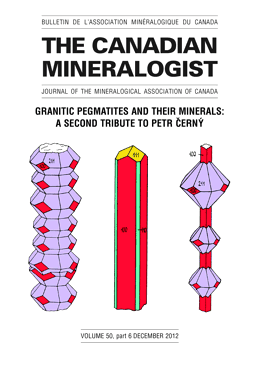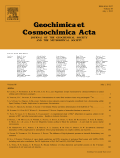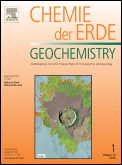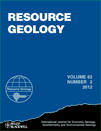
CANADIAN MINERALOGIST
Scope & Guideline
Fostering Scholarly Excellence in Mineral Research
Introduction
Aims and Scopes
- Mineral Chemistry and Geochemistry:
Research exploring the chemical compositions and geochemical processes of minerals, including trace and rare earth element distributions. - Petrogenesis and Mineral Formation:
Studies that investigate the origins and formation processes of minerals, particularly in relation to igneous and metamorphic processes. - Mineral Classification and New Mineral Descriptions:
The journal features taxonomic studies and the description of new mineral species, contributing to the classification systems in mineralogy. - Applied Mineralogy:
Research with practical implications, including the exploration and extraction of minerals for industrial applications, environmental mineralogy, and mineral resources. - Isotope Geochemistry:
Investigations using isotopic systems to understand the geological history and processes involved in mineral formation and alteration.
Trending and Emerging
- Critical and Rare Earth Elements:
A notable increase in research focusing on critical minerals, particularly rare earth elements, underscores their importance in modern technology and industry. - Geochemical Analysis Techniques:
Emerging methodologies such as advanced geochemical analysis, isotopic studies, and mineral characterization techniques are gaining traction, reflecting a push towards more precise and detailed investigations. - Environmental and Sustainable Mineralogy:
There is a growing emphasis on the environmental impact of mineral extraction and processing, with studies addressing sustainable practices and remediation strategies. - Mineral Reactions and Alteration Processes:
Research into the alteration processes of minerals, particularly in relation to climate change and geological hazards, is becoming increasingly relevant. - Interdisciplinary Approaches:
An emerging trend is the integration of mineralogy with other scientific disciplines, such as geology, environmental science, and materials science, promoting a holistic understanding of minerals.
Declining or Waning
- Traditional Mineralogy:
Topics solely focused on classical mineralogical studies are becoming less frequent, possibly due to a greater emphasis on integrative approaches combining mineralogy with geochemistry and petrology. - Economic Geology:
Research centered exclusively on the economic aspects of mineral deposits, such as mining practices and profitability, has seen a decline as the journal shifts towards more scientific and fundamental mineral studies. - Generalized Mineral Descriptions:
There is a noticeable reduction in papers that provide broad, generalized descriptions of mineral occurrences without a strong analytical or research-based context.
Similar Journals

MINERALOGY AND PETROLOGY
Charting New Frontiers in Mineral and Rock StudiesMINERALOGY AND PETROLOGY, published by Springer Wien, is a premier academic journal that has been contributing to the fields of geochemistry, petrology, and geophysics since its inception in 1987. With an ISSN of 0930-0708 and an E-ISSN of 1438-1168, this journal is recognized for its rigorous peer-reviewed articles that advance the understanding of mineral and rock formation processes, their physical and chemical properties, and the implications for broader Earth sciences. Holding a respectable impact factor and categorized in the Q2 quartile for both Geochemistry and Petrology, as well as Geophysics, MINERALOGY AND PETROLOGY ranks favorably among its peers, placing it within the top 50% of scholarly publications in these fields. Researchers, professionals, and students alike will find a wealth of knowledge in its pages, as it serves as a valuable resource for those aiming to explore the complexities of Earth's materials and compositions. Although it does not offer an Open Access option, the journal assures high-quality, impactful research that is crucial for ongoing advancements in Earth sciences.

GEOCHIMICA ET COSMOCHIMICA ACTA
Driving Innovation in Earth and Planetary SciencesGEOCHIMICA ET COSMOCHIMICA ACTA is a premier journal dedicated to advancing the fields of geochemistry and petrology, published by Pergamon-Elsevier Science Ltd. With its ISSN 0016-7037 and E-ISSN 1872-9533, this esteemed journal has been at the forefront of scientific inquiry since its inception in 1950, with a strong commitment to disseminating high-quality research through 2024. Its reputation is underscored by an impressive impact factor and a ranking of #8 out of 154 in Earth and Planetary Sciences according to Scopus, placing it in the 95th percentile of its category. GEOCHIMICA ET COSMOCHIMICA ACTA serves as a critical resource for researchers, professionals, and students alike, offering insights into the complex interactions of geological and cosmological processes. While the journal is not open access, it remains a vital conduit for innovative research, fostering the scientific community’s understanding of earth materials and their significance.

MINERALIUM DEPOSITA
Charting New Frontiers in Economic GeologyMINERALIUM DEPOSITA is a premier journal in the fields of Economic Geology, Geochemistry, and Petrology, published by Springer. With an impressive 2023 impact factor and designated as Q1 in its category, this journal stands out in the academic landscape, showcasing the latest research and developments from 1966 to 2024. With a prominent rank in Scopus, holding the 3rd position in both Geophysics and Geochemistry and Petrology, it represents an invaluable resource for researchers and professionals alike. Although open access options may not be available, the journal's comprehensive coverage of mineral deposits promotes the global exchange of knowledge and advances in our understanding of the geological sciences. Positioned in Germany, MINERALIUM DEPOSITA serves as a crucial platform for innovative discussions, making it essential reading for students, professionals, and academics dedicated to exploring the complexities of earth sciences.

LITHOLOGY AND MINERAL RESOURCES
Uncovering Insights in Geochemistry and PetrologyLITHOLOGY AND MINERAL RESOURCES, published by PLEIADES PUBLISHING INC, is a specialized journal dedicated to advancing knowledge in the fields of economic geology, geochemistry, and petrology. With its ISSN 0024-4902 and E-ISSN 1608-3229, this journal has established itself as a critical resource for scholars and practitioners alike, examining the intricate relationships between lithology and mineral deposits, and their implications for resource management. As indicated by its positioning in the Q3 quartile for both economic geology and geochemistry and petrology in 2023, the journal is recognized for its valuable contributions to the scientific community, ranking #28 out of 43 in Economic Geology and #112 out of 154 in Geochemistry and Petrology according to Scopus. The journal's publication history reveals a rich tradition of excellence, as it has been continuously contributing to the field from 1984 to 2024. While it does not offer open access options, researchers and practitioners can easily engage with its robust body of work in effective ways to support their own studies and applications. The importance of LITHOLOGY AND MINERAL RESOURCES lies in its commitment to publishing high-quality research that informs practices in mineral exploration and environmental stewardship, making it an essential resource for anyone invested in the future of earth sciences.

AMERICAN MINERALOGIST
Transforming Insights into Mineralogy and GeochemistryAMERICAN MINERALOGIST, published by the Mineralogical Society of America, stands as a premier journal in the fields of geochemistry and petrology, as well as geophysics, characterized by its prestigious Q1 ranking in both disciplines in 2023. As a vital resource for researchers, professionals, and students, the journal presents cutting-edge research, comprehensive reviews, and innovative methodologies in mineralogy and allied earth sciences. With converged publication years extending from 1968 to the present, it highlights significant advancements and breakthroughs within the realm of mineralogy. The journal's rigorous peer-review process ensures high-quality content that is both informative and impactful, making it essential reading for anyone engaged in earth sciences. Though it does not offer open access, the journal remains widely accessible through academic libraries, providing users with a wealth of knowledge to advance their understanding of mineralogical sciences.

MINERALOGICAL MAGAZINE
Fostering Global Dialogue in Earth SciencesMINERALOGICAL MAGAZINE, published by Cambridge University Press, is a distinguished journal dedicated to advancing the field of mineralogy and its related disciplines, including geochemistry and petrology. With its ISSN 0026-461X and E-ISSN 1471-8022, this quarterly journal has successfully carved a niche since its inception, contributing critical research and insights from 1969, with ongoing publications up to 2024. Holding a commendable Q2 ranking in the field, it currently occupies the 61st position among 154 journals in its category, reflecting its robust influence as measured by Scopus rankings at the 60th percentile. Scholars and researchers seeking to publish impactful findings in earth sciences will find MINERALOGICAL MAGAZINE an essential platform that not only supports rigorous research but also fosters global discourse within the mineralogical community. Its accessibility ensures that valuable insights reach a wide audience, solidifying its position as a beacon for professionals and students alike in understanding the complexities of mineral compositions and their broader implications on earth science.

Mineralogical Journal-Ukraine
Fostering inclusive access to vital mineralogical findings.Mineralogical Journal-Ukraine is a key academic publication dedicated to advancing the field of mineralogy and geochemistry, under the esteemed auspices of the M.P. Semenenko Institute of Geochemistry, Mineralogy & Ore Formation of NAS Ukraine. Since its inception in 2019, this journal has established itself as an essential resource for researchers and professionals engaged in the study of energy, fuel technology, and the earth sciences, despite its present rankings reflecting a developing impact within these specific categories on Scopus. Published in Ukrainian and available in both print and online formats, the journal not only aims to disseminate high-quality research but also encourages inclusive access to vital findings in mineral exploration, petrology, and geochemical processes. With a commitment to excellence and an expanding scope of research, Mineralogical Journal-Ukraine stands as a pivotal platform for innovation and collaboration among scientists striving to understand the complexities of mineral formation and ore deposits.

Geochemistry
Unraveling the Complexity of Earth SystemsGeochemistry is a distinguished academic journal published by Elsevier GmbH, focusing on the intricate study of geochemical processes across earth systems. With its ISSN 0009-2819 and E-ISSN 1611-5864, this journal serves as a crucial platform for scholars and researchers eager to disseminate their latest findings in geochemistry, petrology, and geophysics. The journal has established itself within the scientific community, achieving a Q2 ranking in both Geochemistry and Petrology as well as Geophysics, showcasing its significant impact and relevance—ranking 18th out of 165 in Geophysics and 26th out of 154 in Geochemistry and Petrology according to Scopus. From its inception in 1978 to its ongoing contributions through 2024, Geochemistry remains a vital resource for academic discourse and innovation in earth sciences. As an open-access title, it allows for broader dissemination of knowledge, promoting accessibility for researchers, students, and professionals. Whether you are engaged in theoretical research or applied studies, Geochemistry provides the insights necessary to advance our understanding of the planet's chemical complexity.

Journal of Geosciences
Empowering Minds through Cutting-edge Geoscientific ResearchJournal of Geosciences is a distinguished peer-reviewed journal published by CESKA GEOLOGICKA SPOLECNOST, based in the Czech Republic, that serves as a vital platform for the dissemination of innovative research in the field of Earth and Planetary Sciences. With an ISSN of 1802-6222 and E-ISSN of 1803-1943, this journal has established its significance within the academic community, evidenced by its Q3 ranking in both Earth and Planetary Sciences and Geology. The journal covers a broad array of topics, making it an essential resource for researchers, professionals, and students interested in geoscientific advancements and discoveries. The Journal of Geosciences reflects a commitment to high-quality scholarship, embracing a variety of methodologies and interdisciplinary approaches, and provides open access to its content, thereby encouraging global collaboration and knowledge sharing among geoscientists. With a publication history converging from 2007 to 2024, it continues to be a prominent venue for critical conversations and developments in the ever-evolving field of geosciences.

RESOURCE GEOLOGY
Advancing Knowledge in Geology and Resource ManagementRESOURCE GEOLOGY, published by WILEY, is a peer-reviewed journal that serves as a vital platform for the dissemination of innovative research in the fields of geology and geochemistry. With an ISSN of 1344-1698 and e-ISSN 1751-3928, the journal has steadily contributed to the academic community since its inception in 1996, continuing through its planned convergence in 2024. With a Q3 ranking in both Geochemistry and Petrology and Geology categories, RESOURCE GEOLOGY is positioned within the competitive landscape of Earth and Planetary Sciences, ranked 164th and 93rd in its respective categories on Scopus, reflecting its significant contribution to the body of knowledge in these fields. While not an open-access journal, it provides access to essential research that advances our understanding of natural resources and geological processes. The journal is dedicated to publishing high-quality articles that appeal to researchers, professionals, and students looking to deepen their insight into the intricate interplay between geological phenomena and resource management.